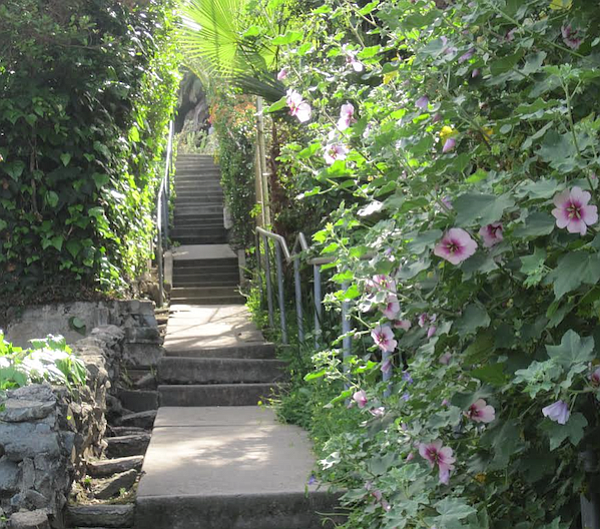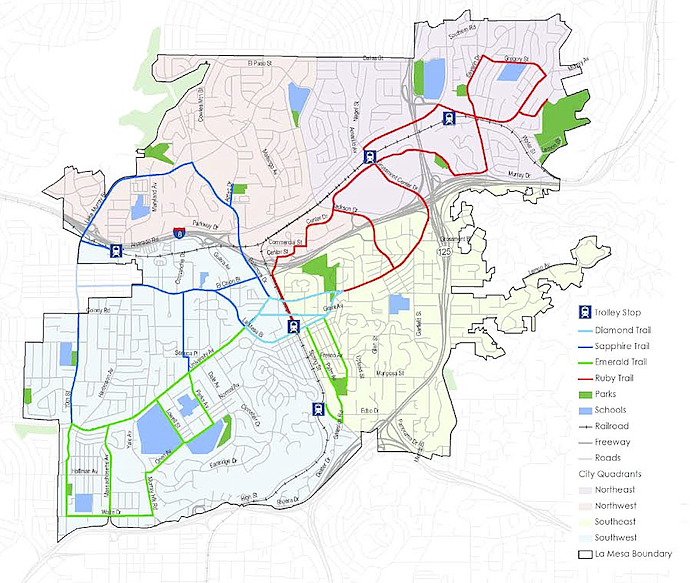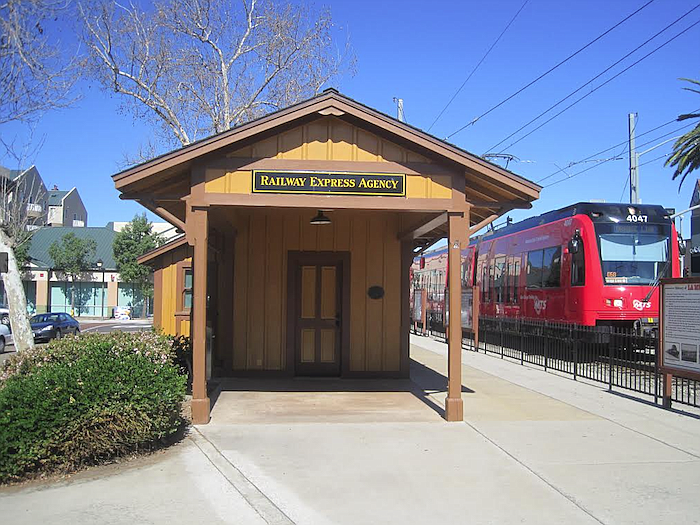 Facebook
Facebook
 X
X
 Instagram
Instagram
 TikTok
TikTok
 Youtube
Youtube

The La Mesa City Council on February 23 unanimously adopted a resolution approving the Urban Trails Mobility Action Plan, "a road map for expansion and improvements for urban trails." The plan created a 22.1-mile network of four major trails. La Mesa’s motto is “Jewel of the Hills,” and proposed trails have jewel names.

According to the plan, urban trails “traverse urban and suburban neighborhoods of a city, connecting various destinations, and are usually prioritized for non-motorized use.” The trails will connect to 9.5 miles of existing urban trails, and new trail priorities foster accessibility to destinations such as parks, schools, medical facilities, shopping, and public transportation. Furthermore, the plan contained a list of 19 priority trail projects; the first 5 were ranked as high priorities because the city has funding for design and construction.
The three existing urban trails “take advantage of the city's varying topography and downtown district.” The downtown Village is the site of the Stroll, an approximately one-mile beginners’ route that starts at the La Mesa Depot (4695 Nebo Drive).

The Stride is an intermediate-level, five-mile route with some uphill sections. It begins at Jackson Park (5870 Jackson Drive). The Challenge is an advanced route of 3.5 miles that begins at Highwood Park (4200 Parks Avenue). “It has much more elevation gain” and includes the hillside Secret Stairs.
The Stroll is on the 2.3-mile Diamond Trail, which “encompasses downtown as the center of the city and is the hub for all trails.” The Stroll is also incorporated into the 7.2-mile Ruby Trail, located in the eastern quadrant of the city; also on this trail are Grossmont Center and Center Street. The Stride is on the 6.3-mile Sapphire Trail, located in the northwest quadrant; the 70th Street trolley station and Lake Murray and El Cajon boulevards are also on this trail.
The Challenge Trail is on the 6.3-mile Emerald Trail, which is in the southwest quadrant; this route passes the Spring Street trolley station and accesses University and Massachusetts avenues.
On the priority list, the Downtown Village Trail ranked first, with the statement that there are “opportunities for urban forestry.” Second on the list is University Avenue Trail, where a $1.9 million San Diego Association of Governments grant will fund improvements, including bicycle lanes and high-visibility crosswalks. Next on the list is the Junior High Trail. There are plans to connect La Mesa Arts Academy to Helix Charter High School by opening Olive Avenue west of Junior High Drive.
Fourth on the list is the Center Street/Spring Street Trail, connecting Grossmont Center to downtown. Described as “one of the most challenging trails,” this portion of Center Street is in an industrial area. San Pasqual Winery and Bolt Brewery are on the 8100 block, near the Center Street bridge. The road without sidewalks is above Interstate 8. A $1.1 million Highway Safety Improvement grant for bicycle and pedestrian safety will be spent on amenities, including sidewalks, bridge safety railings over I-8, and high-visibility crosswalks.
The fifth priority is the Helix High Trail, connecting that school with Vista La Mesa Park.
Public outreach for the plan included walks organized by city staffers. An online survey yielded residents’ concerns about the lack of sidewalks in their neighborhoods.
One person offered suggestions for University Avenue. The street should be reduced to one lane, they said, “because there is rarely enough [vehicular] traffic to warrant two lanes.” Parking could be angled, and a bike lane could be installed between parked vehicles and the sidewalk. A portion of the median could be used for additional space or “use the median as a bike lane.”
While several people opted for biking at Lake Murray instead of streets, one person stated their opposition to pedestrians at the lake.
“Pedestrian traffic congestion is too dangerous. Groups of women and children stretch across the road and don’t pay attention to anything but themselves,” the person wrote.


The La Mesa City Council on February 23 unanimously adopted a resolution approving the Urban Trails Mobility Action Plan, "a road map for expansion and improvements for urban trails." The plan created a 22.1-mile network of four major trails. La Mesa’s motto is “Jewel of the Hills,” and proposed trails have jewel names.

According to the plan, urban trails “traverse urban and suburban neighborhoods of a city, connecting various destinations, and are usually prioritized for non-motorized use.” The trails will connect to 9.5 miles of existing urban trails, and new trail priorities foster accessibility to destinations such as parks, schools, medical facilities, shopping, and public transportation. Furthermore, the plan contained a list of 19 priority trail projects; the first 5 were ranked as high priorities because the city has funding for design and construction.
The three existing urban trails “take advantage of the city's varying topography and downtown district.” The downtown Village is the site of the Stroll, an approximately one-mile beginners’ route that starts at the La Mesa Depot (4695 Nebo Drive).

The Stride is an intermediate-level, five-mile route with some uphill sections. It begins at Jackson Park (5870 Jackson Drive). The Challenge is an advanced route of 3.5 miles that begins at Highwood Park (4200 Parks Avenue). “It has much more elevation gain” and includes the hillside Secret Stairs.
The Stroll is on the 2.3-mile Diamond Trail, which “encompasses downtown as the center of the city and is the hub for all trails.” The Stroll is also incorporated into the 7.2-mile Ruby Trail, located in the eastern quadrant of the city; also on this trail are Grossmont Center and Center Street. The Stride is on the 6.3-mile Sapphire Trail, located in the northwest quadrant; the 70th Street trolley station and Lake Murray and El Cajon boulevards are also on this trail.
The Challenge Trail is on the 6.3-mile Emerald Trail, which is in the southwest quadrant; this route passes the Spring Street trolley station and accesses University and Massachusetts avenues.
On the priority list, the Downtown Village Trail ranked first, with the statement that there are “opportunities for urban forestry.” Second on the list is University Avenue Trail, where a $1.9 million San Diego Association of Governments grant will fund improvements, including bicycle lanes and high-visibility crosswalks. Next on the list is the Junior High Trail. There are plans to connect La Mesa Arts Academy to Helix Charter High School by opening Olive Avenue west of Junior High Drive.
Fourth on the list is the Center Street/Spring Street Trail, connecting Grossmont Center to downtown. Described as “one of the most challenging trails,” this portion of Center Street is in an industrial area. San Pasqual Winery and Bolt Brewery are on the 8100 block, near the Center Street bridge. The road without sidewalks is above Interstate 8. A $1.1 million Highway Safety Improvement grant for bicycle and pedestrian safety will be spent on amenities, including sidewalks, bridge safety railings over I-8, and high-visibility crosswalks.
The fifth priority is the Helix High Trail, connecting that school with Vista La Mesa Park.
Public outreach for the plan included walks organized by city staffers. An online survey yielded residents’ concerns about the lack of sidewalks in their neighborhoods.
One person offered suggestions for University Avenue. The street should be reduced to one lane, they said, “because there is rarely enough [vehicular] traffic to warrant two lanes.” Parking could be angled, and a bike lane could be installed between parked vehicles and the sidewalk. A portion of the median could be used for additional space or “use the median as a bike lane.”
While several people opted for biking at Lake Murray instead of streets, one person stated their opposition to pedestrians at the lake.
“Pedestrian traffic congestion is too dangerous. Groups of women and children stretch across the road and don’t pay attention to anything but themselves,” the person wrote.
Comments